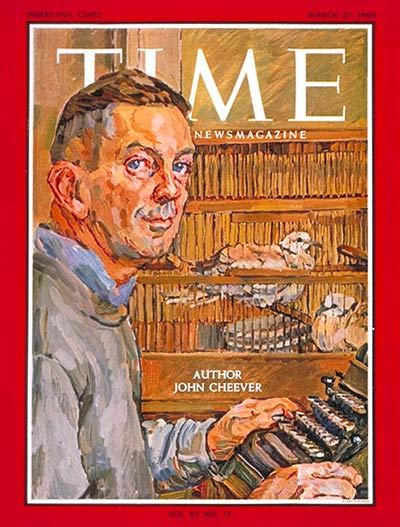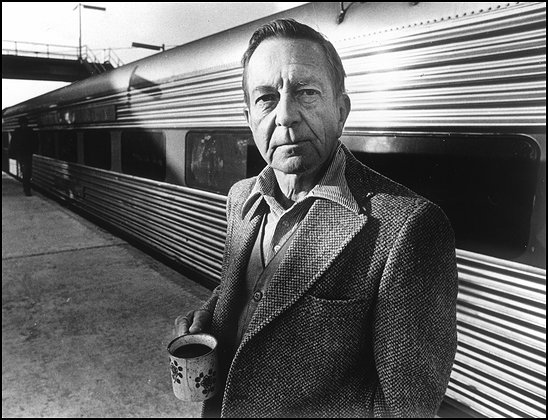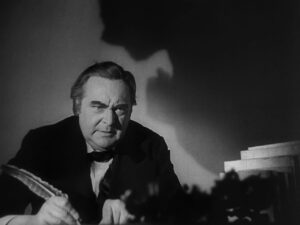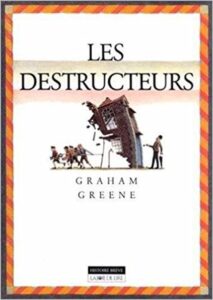Reunion by John Cheever with PDF

You can download a free PDF copy of Reunion by John Cheever right below. You can also download a PDF worksheet as well as the complete analysis below.
Table of contents – Reunion by John Cheever
- Reunion by John Cheever – Full Text
- Plot, Summary and Analysis – Reunion by John Cheever
- Reunion by John Cheever – Full Text – PDF
- Analysis PDF
- Theme PDF
Reunion by John Cheever – Full Text

The last time I saw my father was in Grand Central Station. I was going from my grandmother’s in the Adirondacks to a cottage on the Cape that my mother had rented, and I wrote my father that I would be in New York between trains for an hour and a half, and asked if we could have lunch together. His secretary wrote to say that he would meet me at the information booth at noon, and at twelve o’clock sharp I saw him coming through the crowd.
He was a stranger to me – my mother divorced him three years ago and I hadn’t seen him since – but as soon as I saw him I felt that he was my father, my flesh and blood, my future and my doom. I knew that when I was grown I would be something like him; I would have to plan my campaigns within his limitations.
He was a big, good-looking man, and I was terribly happy to see him again. He struck me on the back and shook my hand.
“Hi, Charlie,” he said.
“Hi, boy. I’d like to take you up to my club, but it’s in the Sixties, and if you have to catch an early train I guess we’d better get something to eat around here.” He put his arm around me, and I smelled my father the way my mother sniffs a rose. It was a rich compound of whiskey, after-shave lotion, shoe polish, woolens, and the rankness of the mature male.
I hoped that someone would see us together. I wished that we could be photographed. I wanted some record of our having been together. We went out of the station and up a side street to a restaurant. It was still early, and the place was empty. The bartender was quarrelling with a delivery boy, and there was one very old waiter in a red coat down by the kitchen door. We sat down, and my father hailed the waiter in a loud voice.
“Kellner!“ he shouted. “Carbon! Cameriere! You!“
His boisterousness in the empty restaurant seemed out of place.
“Could we have a little service here!” he shouted. “Chopchop.” Then he clapped his hands. This caught the waiter’s attention, and he shuffled over to our table.
“Were you clapping your hands at me?” he asked. “Calm down, calm down, sommelier,” my father said.
“If it isn’t too much to ask of you–if it wouldn’t be above and beyond the call of duty–we would like a couple of Beefeater Gibsons.”
“I don’t like to be clapped at,” the waiter said.
“I should have brought my whistle,” my father said.
“I have a whistle that is audible only to the ears of old waiters. Now, take out your little pad and your little pencil and see if you can get this straight: two Beefeater Gibsons. Repeat after me: two Beefeater Gibsons.”
“I think you’d better go somewhere else,” the waiter said quietly.
“That,” said my father, “is one of the most brilliant suggestions I have ever heard. Come on, Charlie, let’s get the hell out of here.”
I followed my father out of that restaurant into another. He was not so boisterous this time. Our drinks came, and he cross-questioned me about the baseball season. He then struck the edge of his empty glass with his knife and began shouting again.
“Garcon! Kellner! Cameriere! You! Could we trouble you to bring us two more of the same.”
“How old is the boy?” the waiter asked.
“That,” my father said, “is none of your God-damned business.”
“I’m sorry, sir,” the waiter said, “but I won’t serve the boy another drink.”
“Well, I have some news for you,” my father said. “I have some very interesting news for you. This doesn’t happen to be the only restaurant in New York. They’ve opened another on the corner. Come on, Charlie.”
He paid the bill, and I followed him out of the restaurant into another. Here the waiters wore pink jackets like hunting coats, and there was a lot of horse tack on the walls. We sat down, and my father began to shout again.
“Master of the hounds! Tallyhoo and all that sort of thing. We’d like a little something in the way of a stirrup cup. Namely, two Bibson Geefeaters.”
“Two Bibson Geefeaters?” the waiter asked, smiling.
“You know damned well what I want,” my father said angrily. “I want two Beefeater Gibsons, and make it snappy. Things have changed in jolly old England. So my friend the duke tells me. Let’s see what England can produce in the way of a cocktail.”
“This isn’t England,” the waiter said.
“Don’t argue with me,” my father said. “Just do as you’re told.”
“I just thought you might like to know where you are,” the waiter said.
“If there is one thing I cannot tolerate,” my father said, “it is an impudent domestic. Come on, Charlie.”
The fourth place we went to was Italian.
“Buon giorno,“ my father said. “Per favore, possiamo avere due cocktail americani, forti, forti. Molto gin, poco vermut.”
“I don’t understand Italian,” the waiter said. “Oh, come off it,” my father said.
“You understand Italian, and you know damned well you do. Vogliamo due cocktail Americani. Subito.”
The waiter left us and spoke with the captain, who came over to our table and said, “I’m sorry, sir, but this table is reserved.”
“All right,” my father said. “Get us another table.”
“All the tables are reserved,” the captain said.
“I get it,” my father said. “You don’t desire our patronage. Is that it? Well, the hell with you. Vada all’inferno. Let’s go, Charlie.”
“I have to get my train,” I said.
“I sorry, sonny,” my father said. “I’m terribly sorry,” He put his arm around me and pressed me against him.
“I’ll walk you back to the station. If there had only been time to go up to my club.”
“That’s all right, Daddy,” I said. “I’ll get you a paper,” he said. “I’ll get you a paper to read on the train.”
Then he went up to a news stand and said, “Kind sir, will you be good enough to favour me with one of your God-damned, no-good, ten-cent afternoon papers?”
The clerk turned away from him and stared at a magazine cover.
“Is it asking too much, kind sir,” my father said, “is it asking too much for you to sell me one of your disgusting specimens of yellow journalism?”
“I have to go, Daddy,” I said. “It’s late.”
“Now, just wait a second, sonny,” he said. “Just wait a second. I want to get a rise out of this chap.”
“Goodbye, Daddy,” I said, and I went down the stairs and got my train, and that was the last time I saw my father.
Reunion by John Cheever – Summary
“Reunion” by John Cheever is a compact yet emotionally charged short story that explores the complexities of father-son relationships and the consequences of personal choices. The narrative unfolds as the unnamed protagonist, a teenage boy, anticipates a reunion with his estranged father during a layover in New York City.
The story begins with the boy’s arrival at Grand Central Terminal, where he is to meet his father for a brief encounter between train connections. The anticipation is tinged with excitement, as the boy imagines the possibilities of this reunion. However, the tone quickly shifts as the father arrives, and it becomes evident that their relationship is strained.
Cheever skillfully captures the tension between the characters through dialogue and subtle gestures. The father’s dismissive attitude toward the waiter and his impatience hint at deeper issues within the relationship. The boy, eager for connection, finds himself perplexed and increasingly uncomfortable in the face of his father’s abrasive behavior.
As the narrative unfolds, it becomes apparent that this reunion is not a joyous occasion but rather a fraught encounter marked by unresolved issues. The father’s critical remarks and domineering demeanor create an atmosphere of discomfort, contrasting sharply with the son’s desire for connection. The strained nature of their relationship becomes more pronounced as they navigate the city, with the father’s erratic behavior heightening the emotional tension.
Cheever employs the symbolism of the restaurant bill as a powerful metaphor for the fractured relationship. When the father leaves without paying the bill, the son is left to settle the debt, underscoring the emotional and psychological toll of their encounter. The unpaid bill becomes a symbol of the unresolved debts and unmet expectations within their relationship.
The climax of the story occurs when the father impulsively leaves the restaurant without explanation, abandoning his son. The abrupt departure leaves the boy bewildered and abandoned in the midst of the city. This poignant moment encapsulates the heart of the narrative, highlighting the emotional wounds inflicted by the father’s actions.
The story concludes with the protagonist reflecting on the impact of this brief yet tumultuous reunion. The emotional fallout is palpable as the boy grapples with feelings of rejection, confusion, and a heightened awareness of the irreparable rift between him and his father. Cheever leaves the resolution open-ended, inviting readers to contemplate the lasting effects of this encounter on the boy’s psyche and the broader themes of familial estrangement.
“Reunion” is a masterfully crafted narrative that packs a profound emotional punch within its brevity. Cheever’s exploration of strained family dynamics, generational conflicts, and the consequences of unresolved issues resonates with readers long after the final words. Through vivid characterization and nuanced storytelling, Cheever creates a narrative that transcends its temporal and cultural setting, offering a timeless exploration of the complexities inherent in familial relationships.
The Maypole of Merry Mount – Analysis
One of the central themes of the story is the clash between freedom and conformity. Merry Mount, with its Maypole and joyous celebrations, represents a community that embraces individual expression, love, and revelry. In contrast, the nearby Puritan settlement adheres strictly to moral codes and religious conformity. The Maypole becomes a powerful symbol embodying this clash, representing the tension between personal liberty and societal constraints.
The characters, particularly Edgar and Edith, serve as vehicles for exploring the theme of individual expression. Their decision to marry amidst the festivities of Merry Mount challenges the Puritans’ stern moral expectations, emphasizing the tension between personal freedom and societal norms. The characters within Merry Mount defy stereotypes, presenting a multidimensional view of individuals living outside conventional societal norms.
The character of Endicott, the Puritan leader, adds depth to the narrative. Initially ordering the destruction of the Maypole, Endicott represents the uncompromising adherence to Puritan values. However, his change of heart introduces a nuanced perspective, showcasing the internal struggle within him. This inner conflict serves as a commentary on the intricate nature of morality and the potential for individuals to transcend societal expectations.
Symbolism plays a crucial role in the story, with the Maypole standing as a potent symbol representing love, freedom, and uninhibited celebration. Its destruction becomes a focal point, marking the triumph of Puritan values over the unrestrained joy of Merry Mount. The Maypole serves as a metaphor for the clash between individual expression and societal norms, emphasizing the consequences faced by those who challenge established orders.
The tragic fate of the inhabitants of Merry Mount teaches us a lot about the irreconcilable differences between the two communities. Despite Endicott’s momentary understanding, the Puritans remain bound by the strict moral codes that govern their society. The story reflects the enduring tension between personal freedom and societal expectations, demonstrating the consequences of daring to defy prevailing cultural order
The Maypole of Merry Mount – Theme
Here are some prominent themes in the story:
- Clash of Cultures:
- The central theme revolves around the clash between the inhabitants of Merry Mount and the nearby Puritan settlement. Merry Mount, with its Maypole and joyous celebrations, represents a community that embraces individual expression, love, and revelry. In contrast, the Puritans adhere strictly to moral codes and religious conformity. The clash of these contrasting cultures serves as a thematic exploration of the tensions between personal liberty and societal constraints.
- Individual Expression vs. Societal Norms:
- The story explores the tension between individual expression and societal norms. Characters like Edgar and Edith challenge the Puritans’ stern moral expectations by marrying amidst the festivities of Merry Mount. The Maypole becomes a symbol of individual expression and the desire for personal freedom, contrasting sharply with the expectations of the Puritan community.
- Symbolism of the Maypole:
- The Maypole itself serves as a powerful thematic symbol. It represents love, freedom, and uninhibited celebration for the inhabitants of Merry Mount. However, it becomes a focal point of moral conflict with the Puritans, symbolizing the clash between individual expression and societal expectations. The Maypole’s significance adds depth to the narrative, shaping the destinies of those who celebrate around it.
- Consequences of Defying Norms:
- The narrative explores the consequences faced by those who defy societal norms. The tragic fate of the inhabitants of Merry Mount highlights the price individuals pay for challenging established orders. The story reflects the enduring tension between personal freedom and societal expectations, demonstrating the consequences of daring to defy prevailing cultural norms.
- Nuanced Morality:
- The character of Endicott, the Puritan leader, introduces a theme of nuanced morality. Initially ordering the destruction of the Maypole, Endicott represents the uncompromising adherence to Puritan values. However, his change of heart showcases the internal struggle within him, highlighting the complexity of moral judgments and the potential for individuals to transcend societal expectations.
- Generational Perpetuation of Values:
- The story touches upon the perpetuation of values across generations. The clash between Merry Mount and the Puritans illustrates how cultural norms are handed down and maintained. The adherence to established values, embodied by the Puritans, reflects the challenge of breaking free from societal expectations and the impact of generational influence on individual choices.
Reunion by John Cheever – Irony
Here are some prominent types of Irony in the story. The father’s behavior throughout the reunion is rife with irony. On the surface, he appears confident and cheerful, creating an initial impression of a positive encounter. However, as the narrative unfolds, the irony becomes apparent as the father’s dismissive attitude, impatience, and ultimately, his abrupt departure reveal the underlying dysfunction in their relationship.
- Situational Irony:
- The premise of the story is inherently ironic. The son eagerly anticipates the reunion with his father, expecting a joyous and meaningful encounter. However, the actual meeting unfolds in a way that is starkly different from the son’s expectations. The situational irony lies in the stark contrast between the anticipated warmth of the reunion and the cold, strained reality of the encounter.
- Verbal Irony:
- Throughout the narrative, there are instances of verbal irony that add layers of meaning to the dialogue. The father’s seemingly benign statements take on a sarcastic or dismissive tone, revealing an underlying tension in their relationship. For example, the father’s comment about the son’s school performance being “okay” carries an ironic weight, suggesting a lack of genuine interest or approval.
- Dramatic Irony:
- The reader is privy to the son’s inner thoughts and emotions, creating a sense of dramatic irony. While the son remains hopeful and eager for a positive connection with his father, the reader senses the impending disappointment and tension that will characterize their interaction. This dramatic irony contributes to the poignancy of the story.
Reunion by John Cheever – Short story – Full Text – PDF
Are you looking for a free downloadable PDF copy of Reunion by John Cheever? You’re in luck and look no further! You can download a free PDF copy right below.
Reunion by John Cheever – Full Text PDF
Reunion by John Cheever – Analysis – PDF
Are you looking for the analysis PDF copy of Reunion by John Cheever? You’re in luck and look no further! You can download a free PDF copy right below.
Reunion by John Cheever – Analysis
Reunion by John Cheever – Irony – PDF
Are you looking for the PDF copy of irony in Reunion by John Cheever? You’re in luck and look no further! You can download a free PDF copy right below.
Reunion by John Cheever – Irony
Reunion by John Cheever – Theme – PDF
Are you looking for the PDF copy of theme around Reunion by John Cheever? You’re in luck and look no further! You can download a free PDF copy right below.




